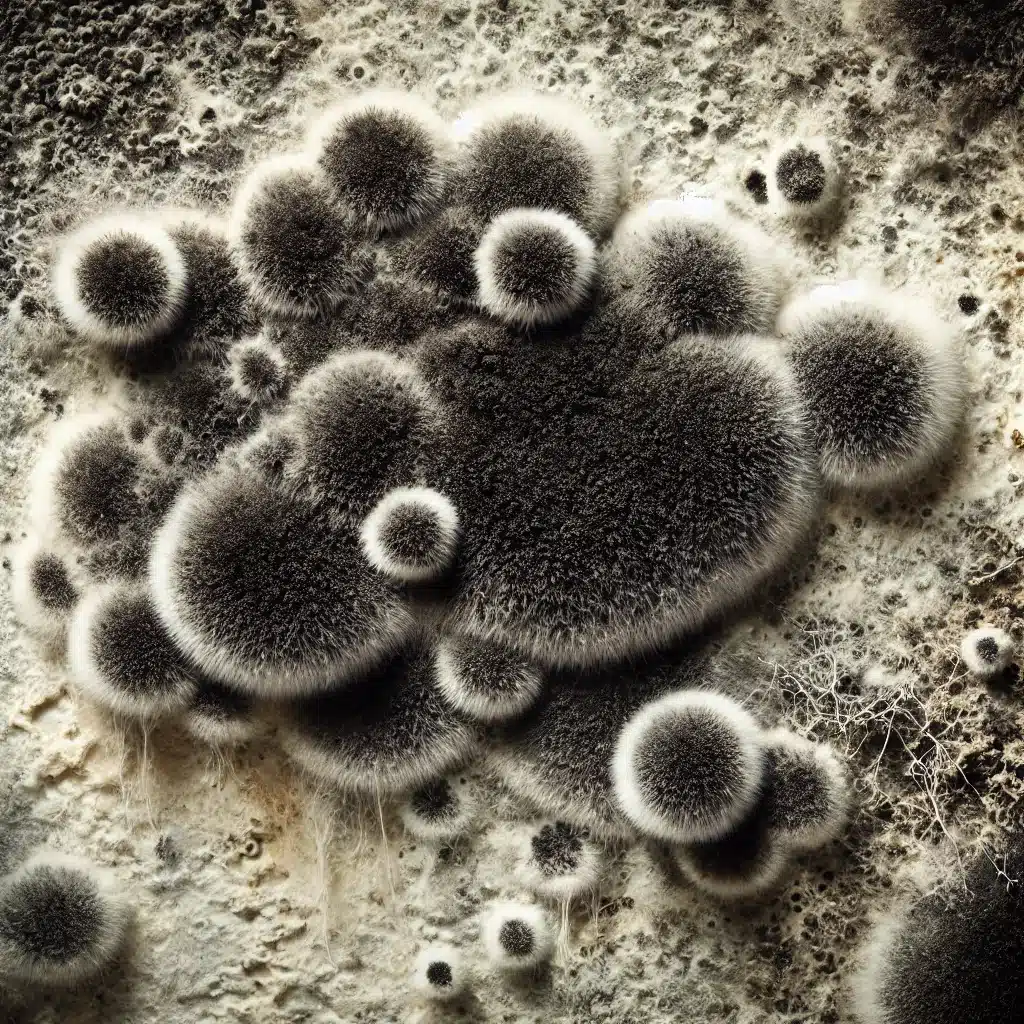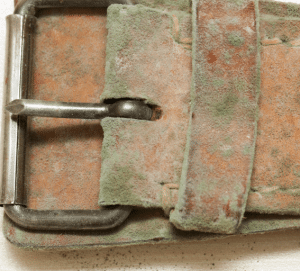“What does black mold look like?” is a question many homeowners ask when they spot mysterious dark spots in their homes. The appearance of black mold can vary, but understanding its characteristics is crucial for identification and subsequent removal.
Black mold, scientifically known as Stachybotrys chartarum, is a common household problem that can pose serious health risks. Recognizing black mold is essential for maintaining a safe living environment, as prolonged exposure can lead to respiratory issues and other health problems. Identifying black mold early allows for prompt action, preventing potential health hazards and further damage to your home.
Characteristics of Black Mold
Visual Appearance
- Color: Black mold is typically black or dark green. These colors are a key identifier when trying to determine if mold is black mold.
- Texture: Black mold often has a slimy or fuzzy texture. This can be seen upon close inspection of the affected areas.
- Shape: It usually appears in irregular patches. These patches often have rounded edges and can vary in size.
Growth Patterns
- Common Locations: Black mold thrives in damp, humid areas. Common places where you might find black mold include bathrooms, basements, and kitchens. These environments provide the moisture necessary for black mold to grow.
- Spread: Black mold often appears in clusters or spots. This means you might see multiple patches of mold close together, forming a pattern of spots on walls, ceilings, or other surfaces.
By recognizing its color, texture, shape, and common growth patterns, you can take the necessary steps to manage and eliminate black mold effectively.
Identifying Black Mold in Different Environments
Indoor Signs
- Wall Surfaces: Black mold on walls often causes peeling paint and discoloration. Look for areas where the paint is bubbling or peeling, and check for any dark patches or stains.
- Ceilings: On ceilings, black mold appears as dark spots or streaks. These can be particularly noticeable in areas with poor ventilation or where moisture accumulates, such as bathrooms and kitchens.
- Hidden Areas: Black mold can grow behind wallpaper and under carpets. If you notice a musty smell or have persistent allergic reactions, it is worth checking these hidden areas for mold growth.
Outdoor Signs
- Window Sills: On window sills, black mold usually appears as dark growth around the edges. This is often due to condensation and poor sealing around windows.
- Exterior Walls: On exterior walls, black mold can manifest as streaks or patches. These areas are typically where water tends to run down or accumulate, such as near gutters or downspouts.
Understanding “what does black mold look like” in various environments is essential for effective identification and remediation. By recognizing these indoor and outdoor signs, you can address mold issues promptly and prevent further damage to your property.
Health Risks Associated with Black Mold
Immediate Symptoms
- Respiratory Issues: Exposure to black mold can cause coughing, sneezing, and wheezing. These symptoms are often the first indicators of mold-related health problems.
- Skin Irritation: Contact with black mold can lead to rashes and itching. Skin irritation may occur when touching moldy surfaces or from airborne mold spores.
Long-term Health Effects
- Chronic Respiratory Conditions: Prolonged exposure to black mold can lead to chronic respiratory conditions such as asthma and bronchitis. These conditions may worsen over time and require ongoing medical treatment.
- Neurological Issues: Long-term exposure to black mold has been linked to neurological issues, including headaches and memory loss. These symptoms can significantly impact daily life and overall well-being.
Recognizing the immediate symptoms and long-term health effects can help in taking prompt action to mitigate exposure and seek appropriate medical care.
Preventing and Managing Black Mold
Prevention Tips
- Controlling Humidity Levels: Keep indoor humidity levels below 60% to prevent black mold growth. Use dehumidifiers in damp areas like basements and bathrooms.
- Ensuring Proper Ventilation: Proper ventilation in high-moisture areas, such as kitchens and bathrooms, helps reduce humidity. Use exhaust fans and open windows regularly.
- Regular Cleaning and Maintenance: Clean and maintain your home regularly. Pay special attention to areas prone to moisture and mold, such as showers, sinks, and basements.
Management Strategies
- Identifying and Fixing Leaks: Regularly check for and repair leaks in roofs, walls, and plumbing. Addressing leaks promptly prevents water accumulation and mold growth.
- Using Mold-Resistant Products: When renovating or building, use mold-resistant products, such as mold-resistant drywall and paint, to reduce the risk of mold growth.
- Professional Mold Removal Services: If black mold is extensive or persistent, hire professional mold removal services. Experts can safely and effectively remove mold and address underlying issues.
Implementing these prevention tips and management strategies, you can reduce the risk of black mold in your home and ensure a healthier living environment.
FAQs About Black Mold
What does black mold look like?
Black mold appears as dark, slimy, or fuzzy patches, usually in damp areas. Recognizing these characteristics can help in identifying mold early.
Where is black mold commonly found?
Black mold thrives in moist environments like bathrooms, basements, and kitchens. These areas provide the humidity and warmth that mold needs to grow.
Can black mold affect my health?
Yes, black mold can cause respiratory problems, skin irritation, and more severe health issues over time. It’s important to address mold problems promptly to minimize health risks.
How can I prevent black mold in my home?
To prevent black mold, keep humidity levels low, ensure good ventilation, and fix any leaks promptly. Regular cleaning and maintenance are also crucial.
Do I need a professional to remove black mold?
For extensive infestations, professional removal is recommended to ensure safety and thoroughness. Professionals have the expertise and equipment to handle mold effectively.
Conclusion
Understanding what black mold looks like and recognizing its signs can help you take timely action to protect your health and home. By being aware of its appearance, common locations, and the health risks associated with black mold, you can address potential issues promptly and effectively.
If you suspect black mold in your home, don’t hesitate to seek professional assistance. Early intervention is crucial to prevent further health complications and property damage.
For reliable and comprehensive mold inspection and removal services, contact Mold Testing Houston. Their experts can help ensure your home is safe and mold-free.
End Note
Mold Testing Houston understands the importance of a mold-free home in maintaining your health and peace of mind. Whether you’re in The Woodlands or the heart of Houston, we are committed to safeguarding your home from mold-related health risks. Our comprehensive range of mold testing services is designed to detect even hidden mold infestations, ensuring your living space remains safe and healthy.
Wondering, “what does black mold look like”? Our blog is a valuable resource for understanding the importance of mold testing, providing you with the latest tips and information. We invite you to follow us on Facebook to stay updated on best practices and helpful insights.
Our dedication to top-notch service and your well-being is at the core of everything we do. Don’t wait for mold to become a problem. Visit our Contact page today to schedule a mold testing appointment and take the first step towards a healthier home.
To learn more about our mission and the passionate professionals behind our success, visit our About Us page. Join the many satisfied customers who trust Mold Testing Houston to keep their homes mold-free, creating a healthier living space for their families. Your health and safety are our top priorities.





